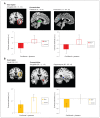The maternal brain in women with a history of early-life maltreatment: an imagination-based fMRI study of conflictual versus pleasant interactions with children
- PMID: 29947610
- PMCID: PMC6019349
- DOI: 10.1503/jpn.170026
The maternal brain in women with a history of early-life maltreatment: an imagination-based fMRI study of conflictual versus pleasant interactions with children
Abstract
Background: Early-life maltreatment has severe consequences for the affected individual, and it has an impact on the next generation. To improve understanding of the intergenerational effects of abuse, we investigated the consequences of early-life maltreatment on maternal sensitivity and associated brain mechanisms during mother-child interactions.
Methods: In total, 47 mothers (22 with a history of physical and/or sexual childhood abuse and 25 without, all without current mental disorders) took part in a standardized real-life interaction with their 7- to 11-year-old child (not abused) and a subsequent functional imaging script-driven imagery task.
Results: Mothers with early-life maltreatment were less sensitive in real-life mother-child interactions, but while imagining conflictual interactions with their child, they showed increased activation in regions of the salience and emotion-processing network, such as the amygdala, insula and hippocampus. This activation pattern was in contrast to that of mothers without early-life maltreatment, who showed higher activations in those regions in response to pleasant mother-child interactions. Mothers with early-life maltreatment also showed reduced functional connectivity between regions of the salience and the mentalizing networks.
Limitations: Region-of-interest analyses, which were performed in addition to whole-brain analyses, were exploratory in nature, because they were not further controlled for multiple comparisons.
Conclusion: Results suggest that for mothers with early-life maltreatment, conflictual interactions with their child may be more salient and behaviourally relevant than pleasant interactions, and that their salience network is poorly modulated by the brain regions involved in mentalizing processes. This activation pattern offers new insights into the mechanisms behind the intergenerational effects of maltreatment and into options for reducing these effects.
Conflict of interest statement
Figures


Similar articles
-
Neural processing of the own child's facial emotions in mothers with a history of early life maltreatment.Eur Arch Psychiatry Clin Neurosci. 2019 Mar;269(2):171-181. doi: 10.1007/s00406-018-0929-8. Epub 2018 Jul 28. Eur Arch Psychiatry Clin Neurosci. 2019. PMID: 30056560
-
Maternal sensitivity and the empathic brain: Influences of early life maltreatment.J Psychiatr Res. 2016 Jun;77:59-66. doi: 10.1016/j.jpsychires.2016.02.013. Epub 2016 Feb 23. J Psychiatr Res. 2016. PMID: 26985733
-
Childhood experiences of maltreatment, reflective functioning and attachment in adolescent and young adult mothers: Effects on mother-infant interaction and emotion regulation.Child Abuse Negl. 2019 Jul;93:277-290. doi: 10.1016/j.chiabu.2019.03.024. Epub 2019 May 24. Child Abuse Negl. 2019. PMID: 31132689
-
A systematic review of the association between the childhood sexual abuse experiences of mothers and the abuse status of their children: Protection strategies, intergenerational transmission, and reactions to the abuse of their children.Soc Sci Med. 2019 Jul;233:113-137. doi: 10.1016/j.socscimed.2019.05.004. Epub 2019 May 9. Soc Sci Med. 2019. PMID: 31195192
-
[Impact of early life maltreatment of women on the mother-child relationship : Data from mother-child dyads from Heidelberg and Berlin].Nervenarzt. 2019 Mar;90(3):235-242. doi: 10.1007/s00115-018-0662-6. Nervenarzt. 2019. PMID: 30643951 Review. German.
Cited by
-
How stress can influence brain adaptations to motherhood.Front Neuroendocrinol. 2021 Jan;60:100875. doi: 10.1016/j.yfrne.2020.100875. Epub 2020 Oct 7. Front Neuroendocrinol. 2021. PMID: 33038383 Free PMC article. Review.
-
Chronic trauma impairs the neural basis of empathy in mothers: Relations to parenting and children's empathic abilities.Dev Cogn Neurosci. 2019 Aug;38:100658. doi: 10.1016/j.dcn.2019.100658. Epub 2019 May 14. Dev Cogn Neurosci. 2019. PMID: 31121480 Free PMC article.
-
Stress and reward in the maternal brain of mothers with borderline personality disorder: a script-based fMRI study.Eur Arch Psychiatry Clin Neurosci. 2024 Feb;274(1):117-127. doi: 10.1007/s00406-023-01634-6. Epub 2023 Jun 24. Eur Arch Psychiatry Clin Neurosci. 2024. PMID: 37354380 Free PMC article.
-
Persistent dopamine-dependent remodeling of the neural transcriptome in response to pregnancy and postpartum.bioRxiv [Preprint]. 2025 Jun 2:2025.02.20.639313. doi: 10.1101/2025.02.20.639313. bioRxiv. 2025. PMID: 40060435 Free PMC article. Preprint.
-
Do I care for you or for me? Processing of protected and non-protected moral values in subjects with extreme scores on the Dark Triad.Eur Arch Psychiatry Clin Neurosci. 2023 Mar;273(2):367-377. doi: 10.1007/s00406-022-01489-3. Epub 2022 Oct 8. Eur Arch Psychiatry Clin Neurosci. 2023. PMID: 36208316 Free PMC article.
References
-
- Butchart A, Mikton C. Global status report on violence prevention 2014. Luxembourg: World Health Organisation; 2014.
Publication types
MeSH terms
LinkOut - more resources
Full Text Sources
Medical
